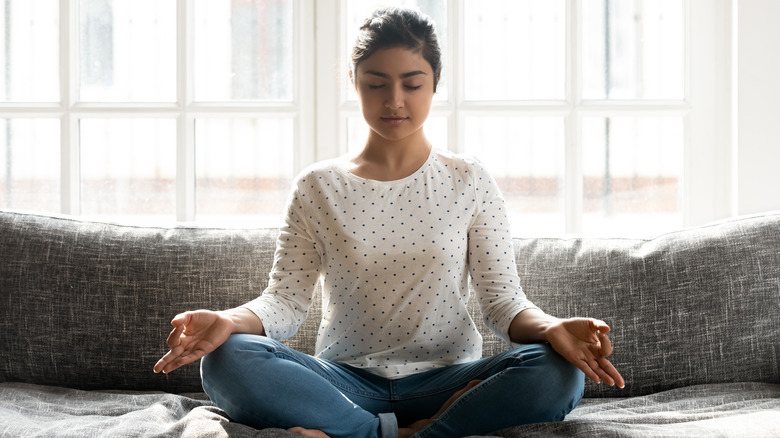What Transcendental Meditation Really Is And How To Try It
Transcendental meditation (TM) has emerged as a simple, effective way to ward off stress and calm your mind. Some say that it also relieves anxiety, lowers blood pressure, and boosts brain power. Clinical research supports these meditation claims. For example, a 2014 review published in the Journal of Alternative and Complementary Medicine reports that TM can decrease anxiety in just two weeks. Its effects last for years.
This practice has been around for about 50 years, according to the Maharishi Foundation. Today, it has more than 6 million practitioners. Maharishi Mahesh Yogi, the guru who introduced it to the public, published several books on its potential benefits and certified over 40,000 meditation teachers (per TMhome). He believed that TM can help people reach their full potential and find happiness.
Unlike traditional meditation, TM doesn't require emptying your mind. Practitioners only need to repeat a mantra for 20 minutes twice a day. While the Maharishi Foundation says that you need a certified TM teacher to get started, you can learn on your own. Like with most things, regular practice is the key.
Transcendental meditation can actually change the brain
Transcendental meditation isn't a religion or a lifestyle, but a way to rewire your brain. This practice allows you to explore the depths of your mind and find inner peace, explains Dr. Tony Nader. He compares the human mind to an ocean, saying that TM enables practitioners to access their deepest thoughts. As a result, they may feel more relaxed, achieve self-awareness, and heal from within. Some practitioners also report improved relationships, greater energy, and better decision-making. But what does the research say?
Clinical evidence published in Psychiatria Danubina suggests that TM may cause changes in brain waves in as little as three months, reducing anxiety. Another study, which was featured in Contemporary School Psychology, reports that TM practice not only lowers anxiety but may also improve sleep and self-confidence. Moreover, it induces feelings of happiness. In a randomized controlled study, school teachers who practiced TM had lower rates of perceived stress, depression, and burnout (via the Permanente Journal).
Like yoga and religious prayer, transcendental meditation triggers the so-called "relaxation response." This state of mind is the opposite of the fight-or-flight response, which occurs during times of stress (via The Harvard Gazette). The TM technique also appears to be more effective at reducing anxiety than conventional treatments and alternative practices, reports a 2014 research paper published in the Journal of Alternative and Complementary Medicine.
How to meditate without attending TM classes
From celebrities to business professionals, millions of people practice transcendental meditation for one reason or another. As Jennifer Aniston said, "I'd say a little over a year ago I started doing TM and that's really changed everything. Starting your day off with that and ending with that is pretty powerful" (via the Maharishi Foundation).
The best part is, you don't need a teacher to get started. Plus, it's not necessary to tweak your diet or lifestyle habits. "The cool thing about this is you don't have to believe in anything. There's no philosophy," David Lynch Foundation director Bob Roth told GQ. What matters most is to settle your mind while letting your thoughts flow.
First, choose a quiet place and close your eyes. Sit in a chair, in bed, or on the floor — whatever you prefer. Ease into your mantra for about 30 seconds and then silently repeat it in your head. As meditation teacher Chandresh Bhardwaj told Byrdie, "Mantra is your key to the soul—it's like a love letter that you share with the cosmic universe."
Don't try to block or analyze your thoughts, but let them come and go. Remain in this state for 20 minutes or longer and then gradually return to your normal self. If you do it right, you should experience a feeling of restful alertness. Consider using an online timer or stopwatch to track your TM sessions. Practice twice a day to fully reap the benefits.


